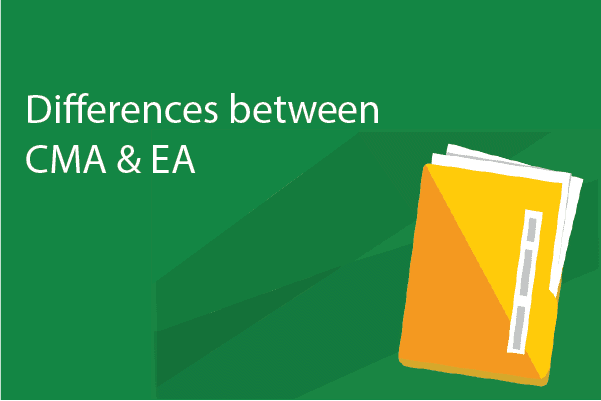This blog is helpful for students with accounting backgrounds. If someone is planning to enhance their accounting career, then it will be beneficial to learn about CMA and EA certifications. There’s a possibility to distinguish the peers by having an accounting designation. But, has a dilemma of which certification to choose, CMA or EA?

We have many options to choose from. The IRS grants the designation of Enrolled Agent, the state board of accountancy awards CPA, and IMA distributes CMA USA certification.
Let’s know the differences between CMA and EA:
Certified Management Accountant (CMA)
CMA is a certification in strategic management and financial accounting. It is offered by the Institute of Management Accountants (IMA) and is a globally recognized credential with a special focus on management accounting. Certified Management Accountants work in corporate finance, accounting, and strategy teams in an organization. CMAs can analyze the data from many sources for performance improvement. Besides, they also crunch numbers for budget analysis and contribute to strategic business decisions.
CMA Duties:
A Certified Management Accountant is qualified in the areas of financial planning, internal control, reporting, budget forecasting, and professional ethics. Typically, CMA work experience can be summarized as follows:
- Arrange funding and financing options.
- Prepare financial statements – balance sheets, income statements, and cash flow statements.
- Identify opportunities for investment management.
- Make presentations to senior management.
- Monitor and administer compliance.
- Act as a mentor and supervise lower-level accountants.
- Create strategies to manage various external and internal risks.
Career Benefits of Getting Your CMA Certification:
CMAs have more demand in a wide variety of industries such as Educational Services, Insurance and real estate, Transportations, Manufacturing, Mining, Medical and health services, Communications and utility services, Finance, Construction.
Career benefits of CMA include:
- High Earnings
- Easier Advancement
- International Appeal
- Career Versatility
Structure of the CMA Exam:
The syllabus for the CMA exam consists of Learning Outcome Statements (LOSs) and Content Specification Outlines (CSOs).
Learning Outcome Statements (LOSs) provides a detailed explanation of skills that are needed for the successful candidate and also specify the tasks should be able to perform by a CMA.
Content Specification Outlines (CSOs) provide consistent coverage on the examination and also establish a strong foundation where the exam will be developed.
In addition to LOS and CSO, the candidate will be expected to possess basic knowledge of elementary statistics, the value of money concepts, and financial statements. One of the best ways to prepare for the CMA exam is to review the provider and map your studies to both LOS and CSo.
Enrolled Agent (EA)
A federally-authorized tax practitioner who has good expertise in taxation is known as an “Enrolled Agent.” EAs often provide tax consultation & prepare a wide range of state and federal tax returns.
Two ways to become an Enrolled Agent:
- By clearing the Special Enrollment Exam (SEE)
- Five years of work experience in Internal Revenue Service (IRS).
Enrolled Agent Duties:
Duties to Clients: To meet the requirements of a business, EAs take reasonable steps to satisfy the clients. Also, they avoid conflicts among unreasonable levels of compensation.
- Personal Duties: EAs must meet their tax obligations and are held to professional standards when interacting with the Internal Revenue Service (IRS) and the clients.
- Duties to the tax administration system: EAs must be very particular on pending cases and honour the protocol while giving tax advice.
Career benefits of an Enrolled Agent:
Career benefits of an Enrolled Agent include:
- No Representation Limitations
- No Degree Required
- Job Market Competitiveness
Structure of the EA Exam:
There are three parts of the Enrolled Agent Exam:
- Individuals
- Businesses
- Procedures and Practices
Each part of the EA exam consists of 100 MCQs, which include 15 experimental questions and 85 scored questions. For future exams, the IRS includes only 15 preliminary questions to test the student’s ability. The exam mixes the scored questions with experimental questions. Besides, the student must answer every question.
Comparison Chart between CMA & EA
| Parameters | CMA | EA |
| Accounting Courses Required | No | No |
| Number of Exams | 2 | 3 |
| Bachelor Degree | Yes | No |
| Exam Length | 8 Hours | 12 Hours |
| Exam Dates per Year | 4 Windows (6 months) | Year-round |
| Estimated Cost | $1,750 | $1,500 |
Conclusion
Now that you’ve had a good overview of CMA vs EA, you have to choose which is better according to your career path. However, I hope this article has given you detailed information and resources to make your choice.
Author Bio:

Anji Velagana is the Content Strategist at Simandhar Education and has 2 years of experience in content writing and blogging. He loves pursuing excellence through writing and has a passion for technology & educational content. Contact him on LinkedIn.





